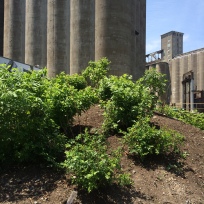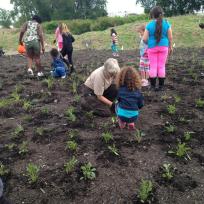Today we are hearing from Denise Clay and Catherine Gatenby from the Lower Great Lakes Fish and Wildlife Conservation Office about their versatile pollinator garden and what it means to Silo City!
For two years, biologists with the Lower Great Lakes Fish and Wildlife Conservation Office have been working with urban school children, girl scouts and volunteers from the Buffalo, NY area to restore habitat at a historic site called Silo City – home to our nation’s longest standing grain elevators, located along the Buffalo River Area of Concern. The site had been invaded by nuisance plant species and was suffering from decades of environmental contamination and habitat degradation.

Silo City, Buffalo NY
Together with many partners, we planted a native garden and restored a steep slope along the riverfront after invasive Japanese knotweed was cleared away, and we created a pollinator garden in an upland area. Local students and girl scouts grew seedlings of milkweed, and then planted them in June with other native flowering plants. Project partners include Silo City and Rigidized Metals Corporation, People United for Sustainable Housing Buffalo, Landscape and Urban Design Department of the State University of New York at Buffalo, Great Lakes Experience Friends group, McKinley High School, Tapestry Charter School, Elmwood Village Charter School and Girls Scouts from Daisy Troop #31055 and Cadet Troop #31313.
These projects not only restore habitat for migrating fish, birds and butterflies, they also are living outdoor classrooms for environment-based curriculums in schools, and serve as public demonstration models for restoring urban habitat for the thousands of Silo City visitors each year.
Students and scouts returned to the project site several times to see first-hand how their actions created healthy habitat for plants and animals. After one month, the area was lush with plants and flowers. In August, students observed monarch caterpillars on milkweed plants growing in the garden. Then in October, we harvested milkweed seeds from the plants and dispersed them to expand the garden for next year.
Additional restoration plans include encouraging native grasslands, improving riverbank habitat, and creating natural drainage pools for collecting run-off from the area before entering the river – all of which will offer public education on how and why restoring habitat is good for people and nature.
We also bring students from the Buffalo and Rochester area out to visit us on the Iroquois NWR. Our goal is to help them follow the through line of natural communities from the Great Lakes through the city to the open big woods and wetlands on the refuge, so they can see how where they live is connected to and part of the natural world.

Elementary schoolchildren from northern Buffalo area enjoy a day in the woods, exploring nature through the lens of photography. Pathways Intern and Biologist, Kwamina Otseidu leads the group.
Students enjoy a day of learning, exploring and photographing nature, followed by writing about their experiences. Students then receive a framed print of one of their photographs with their personal reflection captioned below, to share with friends and family – and as a keepsake from us which we hope will inspire them to keep exploring.

Woods in Black and White. “This is my favorite picture because I like how the forest looks in black and white. I also like how all the light makes the forest stand out. It gives a different view of the plants and trees.” Credit: Kareema Wallace, McKinley High School, Buffalo NY
Through all of our outreach programs, we aim to cultivate environmental awareness, develop connections to outdoor spaces, and foster future land stewards.







![Brook_trout_photo_for_blog[1]](https://usfwsnortheast.files.wordpress.com/2014/10/brook_trout_photo_for_blog1.jpg?w=625)
![EBTJV_10TH_anniv_photo_at_NCTC[1]](https://usfwsnortheast.files.wordpress.com/2014/10/ebtjv_10th_anniv_photo_at_nctc1.jpg?w=625)
![Lynn_Camp_Prong,_Great_Smoky_Mountains_National_Park[1]](https://usfwsnortheast.files.wordpress.com/2014/10/lynn_camp_prong_great_smoky_mountains_national_park1.jpg?w=625)

![Long_Mt._Brook_Culvert_Replacement_-_Before[1]](https://usfwsnortheast.files.wordpress.com/2014/10/long_mt-_brook_culvert_replacement_-_before1.jpg?w=221&h=300)
![Long_Mt._Brook_Replacement-After[1]](https://usfwsnortheast.files.wordpress.com/2014/10/long_mt-_brook_replacement-after1.jpg?w=262&h=300)





